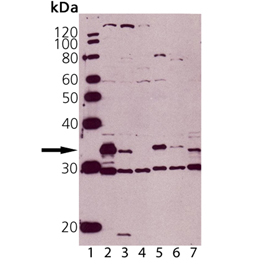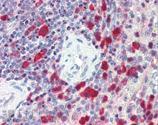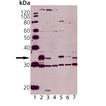Product Details
| Host: | Rabbit |
| |
| Immunogen: | Recombinant human Caspase-3 protein (full length). |
| |
| UniProt ID: | P42574 |
| |
| GenBank ID: | U26943 |
| |
| Source: | Purified from rabbit serum. |
| |
| Species reactivity: | Human, Mouse, Rat
Bovine, Chicken, Dog, Guinea pig, Hamster, Monkey, Porcine, Rabbit, Yeast
|
| |
| Applications: | IHC (PS), WB
|
| |
| Recommended Dilutions/Conditions: | Western Blot (1:1,000, ECL)
Suggested dilutions/conditions may not be available for all applications.
Optimal conditions must be determined individually for each application. |
| |
| Application Notes: | Detects a band of ~36kDa by Western blot. A lower molecular weight band refers to a proteolytic cleavage product of caspase-3. |
| |
| Purity Detail: | Protein A affinity purified. |
| |
| Formulation: | Liquid. In PBS containing 50% glycerol and 0.09% sodium azide. |
| |
| Handling: | Avoid freeze/thaw cycles. |
| |
| Shipping: | Blue Ice |
| |
| Long Term Storage: | -20°C |
| |
| Scientific Background: | The caspases are a family of cysteine proteases that cleave after certain aspartate residues, and are primarily recognized as mediators of apoptosis. caspases are synthesized as inactive zymogens that can be cleaved to form active enzymes following the induction of apoptosis by stress or death receptors. Initiator caspases (e.g. caspase-8 and -10) are activated by dimerization of the zymogen on a dedicated adaptor protein. These activated initiator caspases in-turn cleave downstream effector or executioner caspases (e.g. caspase-3, -6, and -7) in a cascade-like manner, which cleave key cellular proteins that lead to the morphological changes associated with apoptotic cell death. |
| |
| Regulatory Status: | RUO - Research Use Only |
| |

Western blot analysis of Caspase-3 pAb: Lane 1: MW Marker, Lane 2: Jurkat (Prod. No. ADI-LYC-JK100), Lane 3: Jurkat treated with staurosporine, Lane 4: MCF-7 (negative control), Lane 5: HeLa, (cell lysate) (Prod. No. ADI-LYC-HL100), Lane 6: Rat Spleen, Lane 7: Mouse Spleen.

Immunohistochemistry analysis of human spleen tissue stained with Caspase-3, pAb at 10µg/ml.
Please mouse over
Product Literature References
Lucanthone, Autophagy Inhibitor, Enhances the Apoptotic Effects of TRAIL through miR-216a-5p-Mediated DR5 Upregulation and DUB3-Mediated Mcl-1 Downregulation: J.Y. Yoon, et al.; Int. J. Mol. Sci.
23, 17 (2022),
Abstract;
Lactucin induces apoptosis through reactive oxygen species-mediated BCL-2 and CFLARL downregulation in Caki-1 cells: J.H. Jang, et al.; Genes Genomics
43, 1199 (2021),
Abstract;
AZD1208, a Pan-Pim Kinase Inhibitor, Has Anti-Growth Effect on 93T449 Human Liposarcoma Cells via Control of the Expression and Phosphorylation of Pim-3, mTOR, 4EBP-1, S6, STAT-3 and AMPK: A.K. Yadav, et al.; Int. J. Mol. Sci.
20, 363 (2019),
Abstract;
Full Text
High metabolic rate and stem cell characteristics of esophageal cancer stem-like cells depend on the Hsp27-AKT-HK2 pathway: C.C. Liu, et al.; Int. J. Cancer
145, 2144 (2019),
Abstract;
Loperamide overcomes the resistance of colon cancer cells to bortezomib by inducing CHOP-mediated paraptosis-like cell death: I.Y. Kim, et al.; Biochem. Pharmacol.
162, 41 (2019),
Abstract;
Combination of NAD+ and NADPH Offers Greater Neuroprotection in Ischemic Stroke Models by Relieving Metabolic Stress: Q. Huang, et al.; Mol. Neurobiol.
55, 6063 (2018),
Abstract;
Differential expression patterns of the short and long isoform of cFLIP on FasL‑mediated apoptosis: H.J. Um, et al.; Oncol. Rep.
39, 2443 (2018),
Abstract;
Novel carbazole sulfonamide microtubule-destabilizing agents exert potent antitumor activity against esophageal squamous cell carcinoma: F. Niu, et al.; Cancer Lett.
420, 60 (2018),
Abstract;
Canonical Wnt/β-Catenin Signaling Regulates Postnatal Mouse Epididymal Development But Does Not Affect Epithelial Cell Differentiation: M. Kumar, et al.; Endocrinology
158, 4286 (2017),
Abstract;
Inhibition of Cathepsin S Induces Mitochondrial ROS That Sensitizes TRAIL-Mediated Apoptosis Through p53-Mediated Downregulation of Bcl-2 and c-FLIP: B.R. Seo, et al.; Antioxid. Redox Signal.
27, 215 (2017),
Abstract;
Sustainability of CD24 expression, cell proliferation and migration, cisplatin-resistance, and caspase-3 expression during mesenchymal-epithelial transition induced by the removal of TGF-β1 in A549 lung cancer cells: S.K. Kim, et al.; Oncol. Lett.
14, 2410 (2017),
Abstract;
Full Text
Chloroquine enhances TRAIL-mediated apoptosis through up-regulation of DR5 by stabilization of mRNA and protein in cancer cells: E.J. Park, et al.; Sci. Rep.
6, 22921 (2016),
Abstract;
Full Text
Eupafolin enhances TRAIL-mediated apoptosis through cathepsin S-induced down-regulation of Mcl-1 expression and AMPK-mediated Bim up-regulation in renal carcinoma Caki cells: M.A. Han, et al.; Oncotarget
7, 65707 (2016),
Abstract;
Full Text
AEBP1 upregulation confers acquired resistance to BRAF (V600E) inhibition in melanoma: W. Hu, et al.; Cell Death Dis.
4, e914 (2013),
Application(s): WB using human melanoma cell lysates,
Abstract;
Full Text
Characterization of stress response in human retinal epithelial cells: V. Giansanti, et al.; J. Cell. Mol. Med.
17, 103 (2013),
Application(s): WB using human adult retinal pigmented epithelial (ARPE-19) cell lysate,
Abstract;
Full Text
Carfilzomib and ONX 0912 inhibit cell survival and tumor growth of head and neck cancer and their activities are enhanced by suppression of Mcl-1 or autophagy: Y. Zang, et al.; Clin. Cancer Res.
18, 5639 (2012),
Abstract;
Sodium butyrate with UCN-01 has marked antitumour activity against cervical cancer cells: A.Z. Decrion-Barthod, et al. ; Anticancer Res.
30, 4049 (2010),
Application(s): WB using HeLa and CaSki cell lysate,
Abstract;
Full Text
Elevated retina-specific expression of the small heat shock protein,αA-crystallin, is associated with photoreceptor protection inexperimental uveitis: N. Rao, et al. ; Invest. Ophthalmol. Vis. Sci.
49, 1161 (2008),
Application(s): WB using mouse cell lysates & tissue,
Abstract;
Inhibition of p53 protects liver tissue against endotoxin-induced apoptotic and necrotic cell death: B. Vollmar, et al. ; FASEB J.
17, 660 (2003),
Application(s): WB using rat samples,
Abstract;
Activation of caspase pathways during iron chelator-mediated apoptosis: S.V. Torti, et al. ; J. Biol. Chem.
277, 25568 (2002),
Application(s): WB using human samples,
Abstract;
Tumor necrosis factor-related apoptosis-inducing ligand-induced death-inducing signaling complex and its modulation by c-FLIP and PED/PEA-15 in glioma cells: C. Hao, et al. ; J. Biol. Chem.
277, 25020 (2002),
Application(s): WB using human samples,
Abstract;
Related Products












